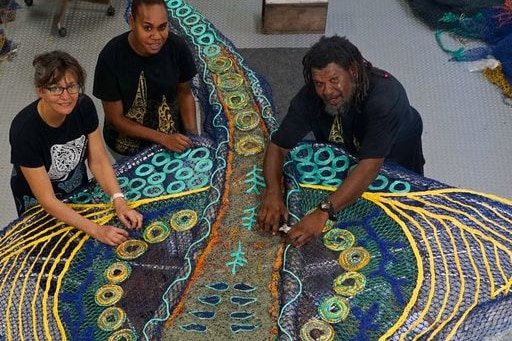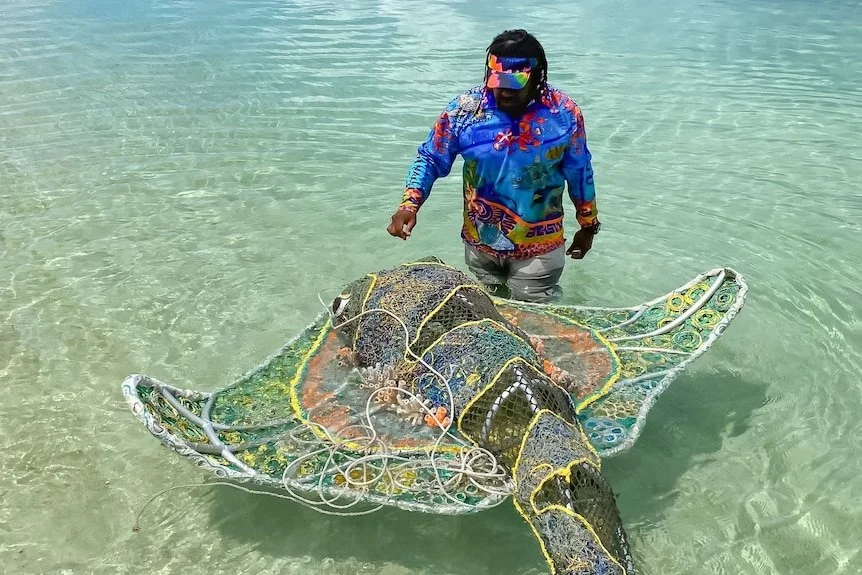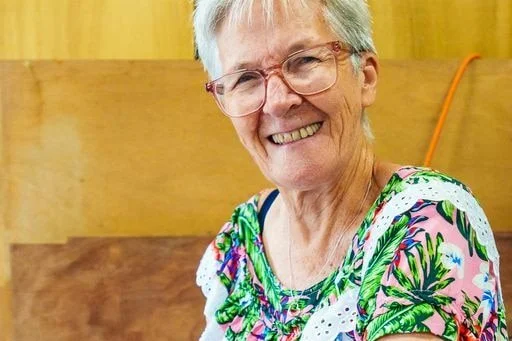Far North Queensland collective gives new life to ghost nets
Story from ABC Far North ByAmanda Cranston
The artists stand around the giant eagle ray crafted from discarded ghost nets, which weighs about 85 kilograms.(Supplied: Kieran James)
Four artists stand around a giant eagle ray made from discarded fishing nets, as they meticulously hand stitch and add colourful embellishments.
Abandoned at sea by commercial fishing boats, these ghost nets once drifted aimlessly along the ocean floor, silently trapping and killing marine life.
But they have found new life through art designed to highlight their destructive legacy.
In Lynnette Griffith's garage in Cairns's northern beaches, members of the Ghost Net Collective are putting the finishing touches to the 2.8-metre creature, the last in their collection.
One of the 11 giant ghost net rays, each about 2.8 metres long.(Supplied: Kieran James)
They sit around their "stitching circle", sharing songs and stories while busy fingers work needles and thin rope.
"The rays will actually look like they're moving through the space and will become electrified with LED lighting at night, creating an immersive experience," Ms Griffith says.
Ms Griffith co-founded the Ghost Net Collective in 2020 and is the project manager and lead artist on this project — one of the largest handcrafted, sustainable public art commissions in Australia.
Called Mermer Waiskeder, meaning Stories of the Moving Tide, the installation curated by Nina Miall is destined for Sydney's Exchange Square at Barangaroo South.
A preview of what the art installation will look like at Sydney's Exchange Square at Barangaroo South.(Supplied: Lendlease)
Once installed early next year, 11 giant ghost net rays — each weighing 85 kilograms — will float gracefully above the crowds to create an underwater aquarium effect.
It is part of the $40 million Barangaroo Public Art and Cultural Contribution and reflects on Barangaroo's early history of fishing, paying homage to the docklands that were once the site of a rope factory.
"The reason we collectively decided on rays is because they are a common sight around Australia and people can relate to them," Ms Griffith says.
Ghost Net Collective artists Lynnette Griffiths and Jimmy John Thaiday with giant eagle ray pieces crafted from nets behind them.(ABC Far North: Amanda Cranston)
Jimmy John Thaiday, an artist from Erub (Darnley Island) in the Torres Strait, explains that each of the 11 eagle rays have their own names and different patterns.
"We have done felting and created patterns like circles, flowers and fish, which give the rays a life and scenery of what's happening in the water," he says.
Mr Thaiday says they acquired most of their ghost nets from Tangaroa Blue, a not-for-profit organisation that collects marine debris from beaches across Australia.
Ropes that were attached to discarded fishing nets are rolled up on the beach on Erub (Darnley Island) in the Torres Strait.(Supplied: Lynnette Griffiths)
Other nets were salvaged from the Sydney Fish Market, providing a local connection to the project.
Once the ghost nets were cleaned and dried, the artists used two or three layers to create each gigantic ray, giving it depth and strength.
Mr Thaiday says it took about six weeks to complete each animal, with help from local school students.
"I've loved this project and it's been really good doing the workshops and working with all the ladies," he says.
An artist with a ghost net ray floating in the water in the Torres Strait.(Supplied: Lynnette Griffiths)
An estimated 12 million tonnes of plastic ends up in the ocean each year, including 640,000 tonnes of ghost gear, according to Greenpeace.
"We hope our use of recycled ghost nets will create conversations about how these invisible, discarded nets are killing not just fish, but turtles, sharks and so much more of our marine life," Ms Griffiths says.
Diann Lui (Supplied: Kieran James)
Diann Lui, manager of Erub Arts on Darnley Island in the Torres Strait, says she hopes the irony of the display is not lost on the public.
"We've repurposed the pollution, the very material that's killing our ocean life and made something sublime and beautiful," she says.
"People will know more about us through this work and better understand our environmental message about marine pollution."
The theme behind the title — Stories of the Moving Tide — suggests time and tide waits for no-one and questions whether time is running out for humans.
It also explains that while the incoming tide brings debris with it, it also symbolises a new beginning.
"To be adding the final touches to our final ray, number 11, it's almost indescribable and quite emotional as we've all put our heart and soul into this project," Ms Lui says.
"That's what art is all about — getting the conversation started."







